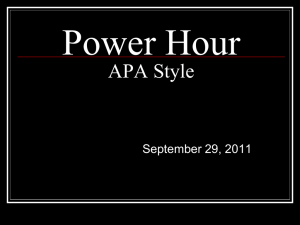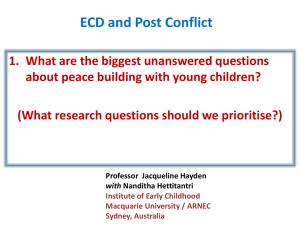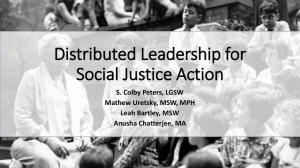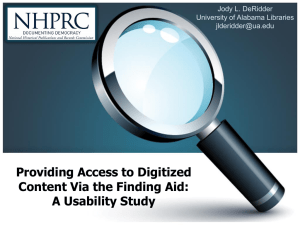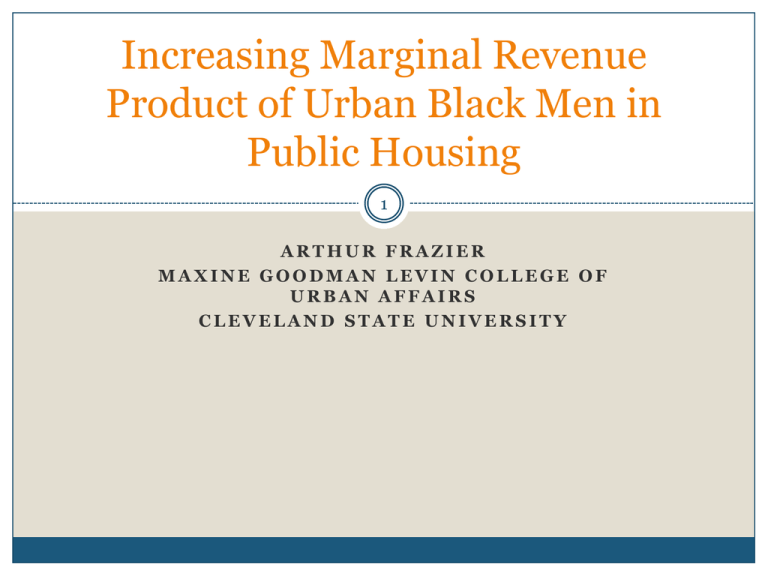
Increasing Marginal Revenue
Product of Urban Black Men in
Public Housing
1
ARTHUR FRAZIER
MAXINE GOODMAN LEVIN COLLEGE OF
URBAN AFFAIRS
CLEVELAND STATE UNIVERSITY
Table of Contents
2
Introduction
Public Housing and Urban Spatial Theory
The Impact of Gautreaux
Human Capital
Soft Skills
Method
Discussion
Conclusion
Introduction
3
From economic perspective many Black males living
in public housing have low productivity and
marginal revenue product (MRP)
MRP is defined as the amount of revenue a firm
generates when it adds one additional unit of input
Input can be labor, capital or both
A worker is valuable to an employer if MRP exceeds
the wage
Public housing urban Black male MRP is not very
productive
Historical Perspective
4
After World War I millions of Blacks came north to
look for work
Many settled in industrial cities such as Chicago,
Detroit, Pittsburgh and Cleveland
Several Blacks had difficulty finding suitable housing
in northern cities and many were forced to live in
urban ghettos
5
During the Great Depression the unemployment rate
for Blacks was 30 to 60 percent higher than Whites
Congress passed the Fair Labor Standards Act in
1938 establishing the minimum wage
However, White employers realized they had to pay
Black workers the same wage as White workers for
equal work and began firing Black workers
As a result, urban Blacks had to accept lower paying
menial jobs and became isolated in ghettos
Public Housing and Urban Spatial Theory
6
Urban spatial theory-Blacks living in urban areas are
isolated from high wage suburban jobs
Large pool of workers relative to available jobs
The urban spatial mismatch theory assumes that
residential location is exogenous. However, other
factors i.e. school quality, transportation, safety may
also influence location
Spatial mismatch alone is not reason for high Black
urban male unemployment
The Impact of Gautreaux
7
More than 60 percent of public housing is located in
central metro areas where there is a large
concentration of minorities
In suburban areas public housing is less than 20
percent of all units
8
In Gautreaux v. Chicago Housing Authority a
federal court ruled that the Chicago Housing
Authority and Housing and Urban Development
(HUD) discriminated against Black tenants by
placing them in large public housing developments
in poor neighborhoods
The case was settled when HUD agreed to give
vouchers to Black tenants which allowed them to
move to areas that were less than 30 percent Black
9
After Gautreaux HUD began to offer more
alternatives to Black tenants such as
1. Moving to Opportunity (MTO)
2. Housing Opportunities for People Everywhere
(HOPE) IV
However, despite more alternatives for tenants and
improvements in public housing, the underlying
problem of urban Black male unemployment did
not improve
Human Capital
10
One reason for high urban Black male
unemployment is lack of human capital
Human capital includes education, experience, and
neighborhood quality
Classic economic models assume that all workers
have the same productive human capital but in
reality that is not the case
11
Studies have found that a 25 percent gap in earnings
and education of Black men can be accounted for in
variation of neighborhood quality
Local productivity is a significant contributor to
positive neighborhood growth
Public schools are very important to neighborhood
growth and nurturing productivity at an early age
If these schools lack resources to effectively teach,
children will not acquire the basic math and reading
skills needed to compete in the job market
12
Consequently urban Black males in public housing
neighborhoods with underperforming public schools
face severe obstacles when trying to acquire human
capital needed to improve employment prospects
One obstacle is a perception that urban Black men
lack soft skills
Soft Skills
13
Definition of soft skills is difficult to quantify even
though employer surveys indicate it is the most
important hiring component for entry level jobs
Four workplace competencies have been identified as
soft skills:
1. Cognitive skills
2. Oral communications
3. Personal qualities/work ethic
4. Interpersonal/teamwork skills
14
Cognitive skills-difficult to measure because they are
often based on mathematical standardized tests such
as the Armed Services Qualification Test (AFQT)
Include ability to identify problems, evaluate
alternative solutions, reaching decisions in a logical
manner, and adjusting to unanticipated situations by
applying established rules
15
Oral communications-ability to communicate
messages appropriate to the audience
Also include being able to understand instruction,
give direction and verify information
Personal qualities/work ethic are skills associated
with self-esteem and willingness to work
There is debate as to whether this is soft skill per se
or a product of soft skills
16
Interpersonal skills include the ability to negotiate,
being a team player, participate in group decisions,
and be able to resolve conflict
When addressing soft skills in the context of
employment three common elements emerge:
1. Soft skills relate to interaction between individuals
2. Soft skills are likely to be environmental specific
3. Soft skills are difficult to define
17
Giloth (1990) identifies two paradigms that relate to
soft skills, workforce strategies and job training
A sector-based paradigm is a belief that development
begins where the jobs are and community
connections to lower-income job seekers follow
This paradigm relies on clusters as a tool for job
creation and economic development
However, a cluster based approach could be biased
against Black males because of the perception that
they lack the soft skills needed to attract firms
18
A place-based paradigm focuses on the need of the
individual job-seeker and seeks to improve job
prospects through community development
In terms of raising Black male MRP, this would be
the most desired approach because performance
criteria common to a sector-based paradigm would
not be considered a barrier to employment
opportunities
Method
19
Research Question: Whether programs addressing
soft skills and job training increase employment
opportunities
Table 1 displays definitions of variables used in
factor analysis and logistic regression obtained from
the data set Survey of Income Participation (SIPP)
2004 Panel
20
Table 1
Employment
EPUBHSE
ELKWRK
EWRKEXP3
EWELACT1
EWELAC21
EWELAC22
EWELAC23
EWELACT3
EWELACT4
Black
ESEX
THEARN
Employment last month
Residence in public housing project
Spent time looking for work
Worked in a work experience
program
Attend classes to improve basic reading
Attend job readiness to learn
Attend job search program or job
club
Attend training to learn a specific job skill
Did ... attend job training
Participate in a work experience
Race
Sex of this person
Total household earned income
21
Table 2 describes 13 employment measures that were
submitted to an exploratory factor analysis
The analysis resulted in five factors with high
loadings pertaining to job search and job club
programs
In addition there were high loadings associated with
attendance at a job readiness program and attending
classes to improve reading
Table 2
Participate in a work experience
Spent time looking for work
Worked in a work experience program
Attend job search program or job club
Black
Did ... attend job training
Attend classes to improve basic reading
Sex of this person
Attend training to learn a specific job
skill
Residence in public housing project
Attend job readiness to learn
Total household earned income
Employment last month
1
2
0.820 22-0.034
0.681
0.113
0.558
-0.54
0.102
0.872
0.001
0.616
0.131
0.159
-0.159 -0.229
0.353
0.127
0.056
0.216
Factor Loadings
3
4
-0.019
0.037
0.063
0.065
0.393
0.017
0.098
0.142
0.218 -0.021
0.800 -0.045
-0.617
0.328
-0.566 -0.309
-0.203
0.693
5 Communalities
0.23
0.728
-0.002
0.485
-0.052
0.760
0.016
0.801
-0.266
0.498
0.101
0.695
0.154
0.590
0.033
0.558
-0.32
0.674
-0.225
0.265
-0.043
0.341
-0.3
0.162
-0.148
-0.004
0.238
-0.077
-0.12
0.691
0.683
-0.018
0.044
0.234
0.074
0.868
0.754
0.730
0.574
0.784
0.701
Eigenvalue
Percent of Total Variance
Percent of Common Variance
2.210
17.003
26%
1.953
15.022
23%
1.725
13.266
20%
1.542
11.859
18%
1.149
8.840
13%
65.989
100%
KMO measure of sampling adequacy =
Bartlett's Test of Sphericity
n = 124
0.515
Approx. Chi-Square =333.389, df= 78, p<.001
23
Table 3 displays the results from logistic regression
predicting the variable Employment which measures
whether a participant held a job during a one month
period
The final statistics revealed significant contributions
of ELKWRK, spent time looking for work,
EWELACT1, a measure of class attendance to
improve reading and THEARN, a measure of
household income
A one unit increase in these variables increased the
odds of the occurrence of the variable Employment
24
Discussion
25
Urban Black males living in public housing have low
MRP
As shown in table 3, a one unit increase in public
housing (EPUBHSE) reduces the odds of
employment by 62 percent
One solution to this problem would involve
increasing psychological capital
26
Luthans (2012) identifies four components of
psychological capital:
1. Self-efficacy –ability to handle unexpected
problems
2. Hope-ability to adapt to changes in order to
accomplish a goal
3. Optimism- positive mental attitude
4. Resilience-successful response to adversity
27
The findings of this study suggest that positive Black
male psychological capital can be developed through
job readiness training and other work related
activities
However, Porter (1995) believes urban entrepreneurs
have the capacity to increase Black male MRP by
directing their talent from the social sector to the
private sector.
As a result, inner cities can become export
communities and become attractive to clusters
Conclusion
28
Black men in public housing face several challenges
However, evidence indicates job training and other
activities such as attending classes to improve
reading and job readiness skills increase the odds of
employment.
Soft skills, human capital and psychological capital
are attributes that can be developed with training
Collaborative effort from public and private sectors
are needed to improve the MRP of Black males living
in public housing
References
29
Baptista, R., Karaoz, M., & Mendonca, J. (2014). The impact of human capital on
the early success of necessity versus opportunity-based entrepreneurs. Small
Business Economics, 42(4), 831-847. doi:10.1007/s11187-013-9502-z
Cappelli, P. (1995). Is the skills gap really about attitudes. California Management
Review, 37(4), 108-124.
Chen, D. J. Q., & Lim, V. K. G. (2012). Strength in adversity: The influence of
psychological capital on job search. Journal of Organizational Behavior, 33(6), 811839. doi:10.1002/job.1814
Conrad, C. (1999). Soft skills and the minority work force. (). Washington D.C.:
Joint Center for Political & Economic Studies.
Covington, K. L. (2009). Spatial mismatch of the poor: An explanation of recent
declines in job isolation. Journal of Urban Affairs, 31(5), 559-587.
doi:10.1111/j.1467-9906.2009.00455.x
De Jong, G. F., & Madamba, A. B. (2001). A double disadvantage? minority group,
immigrant status, and underemployment in the united states. Social Science
Quarterly, 82(1), 117-130. doi:10.1111/0038-4941.00011
Friedlander, S. L. (1972). Unemployment in the urban core; an analysis of thirty
cities with policy recommendations. New York: Praeger.
30
Giloth, R. P. (2000). Learning from the field: Economic growth and workforce development in
the 1990s. Economic Development Quarterly, 14(4), 340-359.
doi:10.1177/089124240001400402
Glaeser, E., & Shapiro, J. (2001). "Is there new urbanism? the growth of U.S. cities in the
1990s,". Cambridge, Mass.: National Bureau of Economic Research.
Goldsmith, A. H., Darity, W., & Veum, J. R. (1998). Race, cognitive skills, psychological capital
and wages. Review of Black Political Economy, 26(2), 9-+. doi:10.1007/s12114-998-1001-0
Goodman, J. S. (1975). The dynamics of urban government and politics. New York: Macmillan.
Holzer, H. J. (1991). The spatial mismatch hypothesis - what has the evidence shown. Urban
Studies, 28(1), 105-122. doi:10.1080/00420989120080071
Holzer, H. J. (2009). The labor market and young black men: Updating moynihan's
perspective. Annals of the American Academy of Political and Social Science, 621, 47-69.
doi:10.1177/0002716208324627
Ihlanfeldt, K. R., & Sjoquist, D. L. (1989). The impact of job decentralization on the economic
welfare of central city blacks. Journal of Urban Economics, 26(1), 110-130. doi:10.1016/00941190(89)90031-4
Ihlanfeldt, K. R., & Sjoquist, D. L. (1998). The spatial mismatch hypothesis: A review of recent
studies and their implications for welfare reform. Housing Policy Debate, 9(4), 849-892.
31
Kain, J. F. (1968). Housing segregation, negro employment, and metropolitan decentralization.
Quarterly Journal of Economics, 82(2), 175-197. doi:10.2307/1885893
Levine, M. L. (1996). African americans and civil rights: From 1619 to the present. Phoenix,
Ariz.: Oryx Press.
Luthans, F. (2012). Psychological capital: Implications for HRD, retrospective analysis, and
future directions. Human Resource Development Quarterly, 23(1), 1-8.
doi:10.1002/hrdq.21119
Mathur, V. K. (1999). Human capital-based strategy for regional economic development.
Economic Development Quarterly, 13(3), 203-216. doi:10.1177/089124249901300301
McConnell, C. R., Brue, S. L., & Flynn, S. M. (2012). Microeconomics: Principles, problems,
and policies (19th ed.). New York: McGraw-Hill/Irwin.
Mooney, J. D. (1969). Housing segregation, negro employment and metropolitan
decentralization - alternative perspective. Quarterly Journal of Economics, 83(2), 299-311.
doi:10.2307/1883085
Moss, P., & Tilly, C. (1996). ''Soft'' skills and race: An investigation of black men's employment
problems. Work and Occupations, 23(3), 252-276. doi:10.1177/0730888496023003002
Mouw, T. (2000). Job relocation and the racial gap in unemployment in detroit and chicago,
1980 to 1990. American Sociological Review, 65(5), 730-753. doi:10.2307/2657544
32
Newman, A., Ucbasaran, D., Zhu, F., & Hirst, G. (2014). Psychological capital: A review and
synthesis. Journal of Organizational Behavior, 35, S120-S138. doi:10.1002/job.1916
Newman, S. J., & Schnare, A. B. (1997). “… And a suitable living environment”: The failure of
housing programs to deliver on neighborhood quality. Housing Policy Debate, 8(4), 703-741.
doi:10.1080/10511482.1997.9521275
O'Neil, H. F., Allred, K., & Baker, E. (1992). Measurement of workforce readiness: Review of
theoretical frameworks. ( No. CSE Technical Report 343). University of California, Los
Angeles: National Center for Research on Evaluation, Standards, and Student Testing.
Pendall, R. (2000). Why voucher and certificate users live in distressed neighborhoods.
Housing Policy Debate, 11(4), 881-910. doi:10.1080/10511482.2000.9521391
Popkin, S. J., Buron, L. F., Levy, D. K., & Cunningham, M. K. (2000). The gautreaux legacy:
What might Mixed‐Income and dispersal strategies mean for the poorest public housing
tenants? Housing Policy Debate, 11(4), 911-942. doi:10.1080/10511482.2000.9521392
Porter, M. E. (1995). The competitive advantage of the inner-city. Harvard Business Review,
73(3), 55-71.
Porter, M. E. (1998). Clusters and the new economics of competition. Harvard Business
Review, 76(6), 77-+.
Rosenbaum, J., Stroh, L., & Flynn, C. (1998). Lake parc place: A study of mixed-income
housing. Housing Policy Debate, 9(4), 703-740.
33
Schiller, B. R. (2011). Essentials of economics (8th ed.). New York:
McGraw-Hill/Irwin.
Turner, M. A., Ellen, I. G., O’Leary, S., & Carnevale, K. (1997).
Location, location, location: How does neighborhood environment
affect the well-being of families and children. Washington, DC:
Mimeograph, Urban Institute,
Ucbasaran, D., Westhead, P., & Wright, M. (2008). Opportunity
identification and pursuit: Does an entrepreneur's human capital
matter? Small Business Economics, 30(2), 153-173.
doi:10.1007/s11187-006-9020-3
vonLockette, N. D. (2010). The impact of metropolitan residential
segregation on the employment chances of blacks and whites in the
united states. City & Community, 9(3), 256-273. doi:10.1111/j.15406040.2010.01332.x
Wilson, W. J. (1987). The truly disadvantaged: The inner city, the
underclass, and public policy. Chicago: University of Chicago Press.


